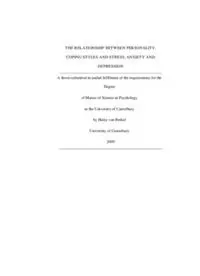
THE RELATIONSHIP BETWEEN PERSONALITY, COPING STYLES AND STRESS, ANXIETY AND ... PDF
Preview THE RELATIONSHIP BETWEEN PERSONALITY, COPING STYLES AND STRESS, ANXIETY AND ...
THE�RELATIONSHIP�BETWEEN�PERSONALITY,� COPING�STYLES�AND�STRESS,�ANXIETY�AND� DEPRESSION� A�thesis�submitted�in�partial�fulfilment�of�the�requirements�for�the� Degree� of�Master�of�Science�in�Psychology� in�the�University�of�Canterbury� by�Haley�van�Berkel� University�of�Canterbury� 2009� � � � � � � � � � � � � Acknowledgements� � � � This�thesis�would�not�have�been�completed�without�the�direction,�support�and�love�from�a�number� of�different�people.� � I�would�firstly�like�to�acknowledge�my�Lord�and�Saviour�Jesus�Christ.�He�has�rescued�me�from�my� sin�and�given�me�eternal�life.�Without�Him�everything�is�meaningless,�a�chasing�after�the�wind.�� � I�would�like�to�thank�my�primary�supervisor�Dr.�Janet�Carter.�Thank�you�for�your�guided�direction� and�your�commitment�to�making�this�thesis�excellent.�I�would�also�like�to�thank�my�co-supervisor� Dr.�Kumari�Fernando.�Thank�you�for�continually�encouraging�me�when�I�was�overwhelmed,�and� providing�me�with�positive�feedback�as�well�as�constructive�criticism.�Thank�you�to�both�of�you�for� taking�on�the�supervisory�role�and�making�me�a�priority�in�your�working�lives.� � Thank�you�also�to�Johannah�Betman�and�Felicity�Daly�for�all�your�help�with�computer�software�and� statistical�analyses.�Your�giving�of�precious�time�was�greatly�appreciated.� � I�would�also�like�to�acknowledge�and�thank�my�mother�Kathy,�who�has�not�only�been�my�mother� for�the�past�25�years�but�also�my�teacher,�my�advisor�and�my�friend.�Thank�you�for�making�it�your� life’s�work�to�shape�me�and�make�me�the�person�I�am�today.�I�would�also�like�to�acknowledge�my� late�father�Nicholas,�who�I�know�would�be�so�proud�of�me,�and�whose�hard�work�and�determination� I�have�inherited.� � Lastly�I�would�like�to�acknowledge�and�thank�my�fiancé�Bruce.�Thank�you�for�your�continued�love� and�support�through�the�good�times�and�the�hard�times.�Throughout�this�period�you�have�helped�me� keep�things�in�perspective.�You�are�my�Rock,�I�can�think�of�no�better�person�to�walk�this�life�with.� � � � Table�of�Contents� � LIST�OF�TABLES....................................................................................................................� iv� � LIST�OF�FIGURES..................................................................................................................� iv�� � � ABSTRACT................................................................................................................................ 1� ...................� � � 1.�INTRODUCTION................................................................................................................� 2� � � 1.1Coping........................................................................................................................................� 2� ��1.1.1�Coping�Styles........................................................................................................................� 3� 1.2�Coping�Style�and�Psychological�Distress.................................................................................� 3� ��1.2.1�Overview...............................................................................................................................� 3� ��1.2.2�Avoidant�Coping�and�Psychological�Distress..................................................................� 4� ��1.2.3�Problem-Focused�Coping�and�Psychological�Distress....................................................� 6� ��1.2.4�Emotion-Focused�Coping�and�Psychological�Distress....................................................� 9� ��1.2.5�Summary..............................................................................................................................� 10� 1.3�Personality................................................................................................................................� 11� ��1.3.1�Personality�Traits�and�their�Associations�with�Stress,�Anxiety�and�Depression............� 12� ��1.3.2�Cloninger's�Psychobiological�Model�of�Personality........................................................� 13� 1.4�Personality�and�Psychological�Distress...................................................................................� 14� ��1.4.1�Harm�Avoidance,�Self-Directedness�and�Psychological�Distress...................................� 14� ��1.4.2�Reward�Dependence�and�Psychological�Distress…….....................................................� 19� ��1.4.3�Summary..............................................................................................................................� 20� 1.5�Personality�and�Coping�Style...................................................................................................� 21� ��1.5.1�Overview...............................................................................................................................� 21� ��1.5.2�Review�of�Personality�and�Coping�Style...........................................................................� 21� ��1.5.3�Review�of�Cloninger's�Psychobiological�Model�and�Coping�Styles...............................� 22� ��1.5.4�Summary.............................................................................................................................� 24� 1.6�Current�Study..........................................................................................................................� 25� � � � 2.�METHOD................................................................................................................................� ��27�� � � 2.1�Participants...............................................................................................................................� 27� 2.2�Procedure..................................................................................................................................� 27� 2.3�Ethical�Approval.......................................................................................................................� 28� 2.4�Measures...................................................................................................................................� 28� ��2.4.1�The�Temperament�Character�Inventory�Revised�(TCI-R;�Cloninger�et�al.,�1994)...............� 28� i� � ��2.4.2�The�Coping�Orientation�of�Problem�Experience�Inventory�(The�COPE;�Carver�et�al.,������������������������������������� 1989)...................................................................................................................................� 34� ��2.4.3�The�Depression�Anxiety�Stress�Scale�(DASS;�S.�H.�Lovibond�&�P.�F.�Lovibond,� � 1995)...................................................................................................................................� 36� 2.5�Statistical�Analyses...................................................................................................................� 38� ��2.5.1�Checking�the�Data�for�Normality.........................................................................................� 38� � � � 3.�RESULTS................................................................................................................................� 41�� � � 3.1�Descriptive�Information...........................................................................................................� 41� 3.2�Examination�of�Data................................................................................................................� 43� 3.3�Relationship�between�Coping�and�Stress,�Anxiety�and�Depression�Variables.......................� 44� ��3.3.1�Coping�Styles�(Problem-Focused,�Emotion-Focused,�Avoidant)�and�Psychological� � Distress...............................................................................................................................� 44� 3.4�Individual�Coping�Styles�and�Psychologial�Distress...............................................................� 45� ��3.4.1�Post�Hoc�Analysis�of�Problem-Focused�Coping�Styles�and�Depression�Scores..................� 45� ��3.4.2�Post�hoc�Analysis�of�Avoidant�Coping�Styles�and�Stress,�Anxiety�and�Depression�� � ������������Scores..................................................................................................................................� 46� 3.5�Relationship�between�Personality�and�Stress,�Anxiety�and�Depression�Variables................� 47� ��3.5.1�Associations�between�Personality�(Harm�Avoidance,�Reward�Dependence,�Self� � Directedness)�and�Psychological�Distress.................................................................................� 47� 3.6�Relationship�between�Personality�and�Coping�Styles.............................................................� 47� ��3.6.1�Associations�between�Personality�Traits�and�Coping�Styles................................................� 47� 3.7�The�Contribution�of�Harm�Avoidance�and�Avoidant�Coping�to�Stress,�Anxiety�and� � Depression...............................................................................................................................� 48� ��3.7.1�The�Contribution�of�Harm�Avoidance�and�Avoidant�Coping�to�Stress...............................� 48� ��3.7.2�The�Contribution�of�Harm�Avoidance�and�Avoidant�Coping�to�Anxiety.............................� 50� ��3.7.3�The�Contribution�of�Harm�Avoidance�and�Avoidant�Coping�to�Depressive� � Symptoms............................................................................................................................� 51� � � � 4.�DISCUSSION............................................................................................................................� 55�� � � 4.1�Comparison�with�Previous�Research.......................................................................................� 55� ��4.1.1�Avoidant�Coping�and�Distress..............................................................................................� 55� ��4.1.2�Problem-Focused�Coping�and�Distress...............................................................................� 56� ��4.1.3�Emotion-Focused�Coping�and�Distress................................................................................� 58� ��4.1.4�Harm�Avoidance�and�Distress..............................................................................................� 60� ��4.1.5�Self-Directedness�and�Distress.............................................................................................� 61� ��4.1.6�Reward�Dependence�and�Distress........................................................................................� 62� ��4.1.7�Personality�and�Coping........................................................................................................� 62� ��4.1.8�The�Contribution�of�Harm�Avoidance�and�Avoidant�Coping�to�Psychological� � Distress...............................................................................................................................� 64� 4.2�Strengths�and�Limitations........................................................................................................� 65� 4.3�Implications�and�Future�Research..........................................................................................� 68� ii� � 4.4�Conclusion................................................................................................................................� 74� � � � � REFERENCES............................................................................................................................. 75� �..................� � � APPENDIX................................................................................................................................... 82�� .�..................� � Appendix�A:�Recruitment�Documentation� � ��Description�of�Study�for�Website,�Poster�Advertisement,�Information�Sheet,�Participant�Contact� � Details,�Consent�Form,�Debrief�Form,�Ethics�Approval...............................................................� 83� Appendix�B:�Materials�used�in�the�Current�Study� � ��Demographic�Information,�Index�of�Questionnaires,�Temperament�Character�Inventory�–�Revised,� � The�Coping�Orientation�of�Problem�Experience,�The�Depression�Anxiety�Stress�Scale.................� 92� � Appendix�C:�Tables........................................................................................................................� 119� � � � iii� � LIST�OF�TABLES� � Table�1.�Description�of�the�TCI-R�Subscales....................................................................................� 32� Table�2.�The�COPE�Subscales�as�used�in�the�Current�Study............................................................� 35� Table�3.�Example�of�Items�in�the�DASS.............................................................................................� 37� Table�4.�Kolmogorov-Smirnov�Testing�of�Data�Normality�Stress,�Anxiety�and�Depressive�� � ���������������Symptoms�(N�=�201)...........................................................................................................� 39� Table�5.�Means,�Standard�Deviations�and�Ranges�Found�for�Personality,�Coping�Styles�and���������� � Psychological�Distress�(N�=�201).......................................................................................� 42� Table�6.�Comparison�of�Descriptive�Statistics�for�Stress,�Anxiety�and�Depression�Levels�with�� � ���������������Past�Studies�(University�and�General�Population)............................................................� 42� Table�7.�Comparison�of�Harm�Avoidance,�Reward�Dependence�and�Self-Directedness�Scores�� � ����������������Across�Past�Studies�(General�Population)........................................................................� 43� Table�8.�Comparison�of�Coping�Style�Scores�with�Past�Studies�(University�and�General�������� � Population).........................................................................................................................� 43� Table�9.�Percentage�of�Participants�Classified�as�Mild,�Moderate,�Severe�Levels�of�Stress,� � Anxiety�and�Depressive�Symptoms)....................................................................................� 44� Table�10.�Association�(Pearson’s�Correlation)�between�Personality,�Coping�Styles�and�Stress,� � Anxiety�and�Depression�(N=201).....................................................................................� 45� Table�11.�Association�(Pearson’s�Correlation)�between�Avoidant�Coping�subscales�and�Stress,� � Anxiety�and�Depression�Variables�(N=201).....................................................................� 46� Table�12.�Associations�between�Personality�Traits�(Harm�Avoidance,�Reward�Dependence,�Self-� � �����������������Directedness�and�Coping�Styles�(Problem-Focused,�Emotion-Focused,�Avoidant)�� � ����������������(N�=�201)...........................................................................................................................� 48� Table�13.�Multiple�Regression�Examining�the�Effect�of�Harm�Avoidance�and�Avoidant�Coping� � on�Stress...........................................................................................................................� 49� Table�14.�Multiple�Regression�Examining�the�Effect�of�Harm�Avoidance�and�Avoidant�Coping� � on�Anxiety........................................................................................................................� 51� Table�15.�Multiple�Regression�Examining�the�Effect�of�Harm�Avoidance�and�Avoidant�Coping�� � ��������on�Depressive�Symptoms.................................................................................................� 52� Table�16.�Table�showing�the�Means�and�Standard�Deviations�for�Harm�Avoidance�and�� � �����������������Avoidant�Coping�as�Psychological�Distress�Increases....................................................� 54� � � � � LIST�OF�FIGURES� � Figure�1.�The�Interaction�between�Harm�Avoidance�and�Avoidant�Coping�in�Predicting� � Depressive�Symptoms................................................................................................� 53� � .�� iv� � Abstract� � Our�personality�and�the�way�we�cope�with�stress�are�two�factors�that�are�important�in�the� development�of�psychological�distress.�The�current�study�explored�the�relationship� between�personality,�coping�styles�and�psychological�distress�in�201�students�from�the� University�of�Canterbury.�Participants�completed�the�Temperament�Character�Inventory�-� Revised�(TCI-R;�Cloninger�et�al.,�1994),�the�Depression�Anxiety�Stress�Scale�(DASS;�S.H.� Lovibond�&�P.F.�Lovibond,�1995)�and�the�Coping�Orientation�of�Problem�Experience� (COPE;�Carver,�Scheier,�Weintraub,�1989).�The�study�showed�that�participants�with�high� harm�avoidance�and�low�self-directedness�reported�increased�stress,�anxiety�and� depression,�while�low�harm�avoidance�and�high�self-directedness�appeared�to�be�a� protective�factor�against�the�development�of�distress.�Avoidant�coping�was�shown�to�be�the� most�maladaptive�coping�style�as�it�was�associated�with�increased�stress,�anxiety�and� depression,�while�problem-focused�coping�appeared�to�reduce�depressive�symptoms.� Strong�associations�were�also�found�between�personality�and�coping�styles,�as�individuals� with�high�reward�dependence�were�more�inclined�to�engage�in�emotion-focused�coping,� while�high�self-directed�individuals�engaged�in�more�problem-focused�coping.�High�harm� avoidance�was�associated�with�avoidant�coping,�resulting�in�greater�distress�than�either� predictor�alone.�The�current�study�suggests�that�our�personality�and�the�coping�styles�we� employ�may�influence�whether�we�experience�stress,�anxiety�and�depressive�symptoms.� Furthermore,�the�association�between�personality�and�coping�styles�suggests�that� individuals�with�maladaptive�personalities�(e.g.�high�harm�avoidance)�are�at�a�greater�risk� for�experiencing�psychological�distress�as�they�are�more�likely�to�use�a�maladaptive�coping� style�such�as�avoidant�coping.�� � 1� � 1.�Introduction� �� The�primary�aim�in�this�thesis�is�to�examine�the�association�between�certain�personality� traits,�coping�styles�and�psychological�distress.�Psychological�distress�can�be� conceptualised�in�a�variety�of�ways.�For�the�purpose�of�this�study�it�will�be�defined�as� symptoms�of�stress,�anxiety�and�depression.�In�this�section�the�previous�research�regarding� the�contribution�of�certain�personality�styles�and�coping�to�psychological�distress�will�be� discussed.�In�addition,�this�research�will�outline�previous�research�that�has�shown�there�is� also�an�association�between�certain�personalities�and�coping�styles.�It�is�argued�that�a� maladaptive�personality�and�a�maladaptive�coping�style�predict�increased�psychological� distress,�relative�to�each�predictor�alone.�The�goal�of�this�study�is�to�provide�greater� understanding�of�the�etiology�and�maintenance�of�stress,�anxiety�and�depression.� Consequently�individuals�may�be�identified�that�are�'at�risk'�for�experiencing�psychological� distress.�� �� 1.1�Coping�� Coping�is�a�process�that�we�as�individuals�employ�every�day.�We�engage�in�coping�when� we�feel�under�stress�or�want�to�manage�a�taxing�situation.�The�process�of�coping�involves� two�components,�appraisal�and�coping�(Lazarus,�1966).�Appraisal�is�the�act�of�perceiving�a� stressor�and�analysing�one's�own�ability�to�deal�with�the�stressor.�Appraisal�can�be�made�in� three�different�conditions:�when�we�have�experienced�a�stressor,�when�we�anticipate�a� stressor�and�when�we�experience�a�chance�for�mastery�or�gain�(Lazarus,�1966).�Once�we� appraise�a�stressful�situation�we�must�decide�how�we�will�respond�or�‘cope’�with�the� stressor,�either�choosing�to�master�it,�reduce�it�or�tolerate�it.�The�coping�style�we�engage�in� is�ultimately�determined�by�whether�we�believe�we�have�the�resources�to�resolve�the� stressor�(Lazarus,�1966).� 2� � 1.1.1�Coping�Styles� There�appear�to�be�three�main�coping�styles�that�people�employ�when�attempting�to�resolve� or�remove�a�stressor:�problem-focused�coping,�emotion-focused�coping�and�avoidant� coping.�Problem-focused�coping�involves�altering�or�managing�the�problem�that�is�causing� the�stress�and�is�highly�action�focused.�Individuals�engaging�in�problem-focused�coping� focus�their�attention�on�gathering�the�required�resources�(i.e.�skills,�tools�and�knowledge)� necessary�to�deal�with�the�stressor.�This�involves�a�number�of�strategies�such�as�gathering� information,�resolving�conflict,�planning�and�making�decisions�(Lazarus�&�Folkman,� 1984).�Emotion-focused�coping�can�take�a�range�of�forms�such�as�seeking�social�support,� acceptance�and�venting�of�emotions�etc�(Carver�et�al.,�1989).�Although�emotion-focused� coping�styles�are�quite�varied�they�all�seek�to�lessen�the�negative�emotions�associated�with� the�stressor,�thus�emotion-focused�coping�is�action-orientated�(Admiraal,�Korthagen,�&� Wubbels,�2000;�Folkman�&�Lazarus,�1980).�The�third�main�coping�style�is�avoidant� coping.�Avoidant�coping�can�be�described�as�cognitive�and�behavioural�efforts�directed� towards�minimising,�denying�or�ignoring�dealing�with�a�stressful�situation�(Holahan,� Holahan,�Moos,�Brennan,�&�Schutte,�2005).�Although�some�researchers�group�avoidant� coping�with�emotion-focused�coping�the�styles�are�conceptually�distinct.�Avoidant�coping� is�focused�on�ignoring�a�stressor�and�is�therefore�passive,�whereas�emotion-focused�coping� is�active�(Admiraal�et�al.,�2000,�Holahan�et�al.,�2005).�� �� � 1.2�Coping�Style�and�Psychological�Distress�� � 1.2.1�Overview��� Although�many�factors�are�involved�in�the�development�of�psychological�distress,�coping� styles�have�been�shown�to�be�a�significant�contributor.�Problem-focused�coping�appears�to� 3� � be�the�most�adaptive�coping�style�as�it�is�associated�with�reduced�psychological�distress.� Alternatively,�avoidant�coping�appears�the�most�maladaptive�as�it�is�associated�with� increased�distress.�(Ben-Zur,�1999;�Bouteyre,�Maurel,�&�Bernaud,�2007;�Carver,�Scheier,� &�Weintraub,�1989;�Crockett�et�al.,�2007;�Folkman,�1997;�Knibb�&�Horton,�2008;� Penland,�Masten,�Zelhart,�Fournet,�&�Callahan,�2000;�Sherbourne,�Hays,�&�Wells,�1995;� Wijndaele�et�al.,�2007).The�results�regarding�emotion-focused�coping�are�more�complex�as� this�coping�style�has�been�associated�with�both�increased�and�decreased�levels�of� psychological�distress�(Network�of�Relationships�Inventory;�Ben-Zur,�1999;�Billings�&� Moos,�1984;�Bouteyre,�Maurel,�&�Bernaud,�2007;�Brown�&�Harris,�1978b;�Brown,� Svrakic,�Przybeck,�&�Cloninger,�1992;�Carver,�Scheier,�&�Weintraub,�1989;�Crockett�et� al.,�2007;�Knibb�&�Horton,�2008;�Penland,�Masten,�Zelhart,�Fournet,�&�Callahan,�2000;� Wijndaele�et�al.,�2007).�This�section�will�analyse�previous�research�to�demonstrate�the� relationship�between�coping�styles�and�psychological�distress.�Particular�focus�will�be� placed�on�university�students�as�this�is�the�area�of�interest�for�the�present�research.���� �� 1.2.2�Avoidant�Coping�and�Psychological�Distress� Avoidant�coping�has�been�shown�to�be�associated�with�greater�distress�than�other�coping� styles.�In�general,�clinically�depressed�participants�experience�less�improvement�and� greater�dysfunction�when�they�engage�in�avoidant�coping�(Billings�&�Moos,�1984).� Holahan�et�al.�(2005)�showed�that�avoidant�coping�is�positively�associated�with�depressive� symptoms�in�a�ten�year�longitudinal�study.�Their�study�examined�the�coping�styles,�life� stressors�and�depressive�symptoms�of�1,211�participants�over�a�ten�year�period.� Participants�were�measured�for�baseline�depression�levels�at�the�initial�testing�period,�four� years�later�and�ten�years�later.�Holahan�et�al.�found�that�individuals�that�engaged�in� avoidant�coping�at�baseline�were�more�likely�to�experience�chronic�and�acute�stressors� when�measured�four�years�later�and�to�exhibit�depressive�symptoms�ten�years�later.� 4� �
